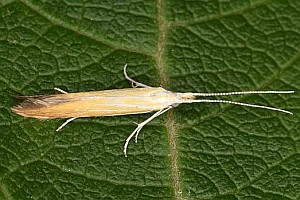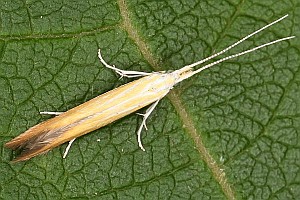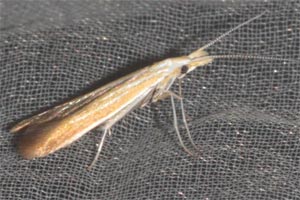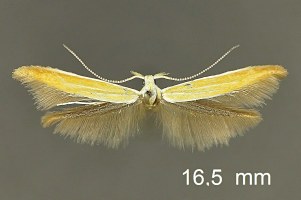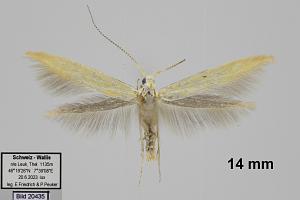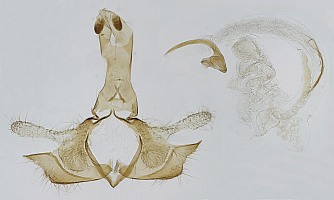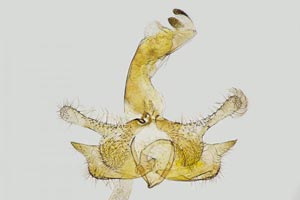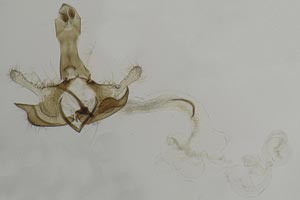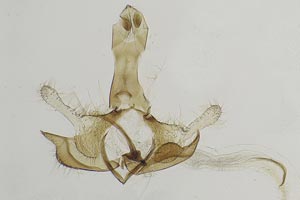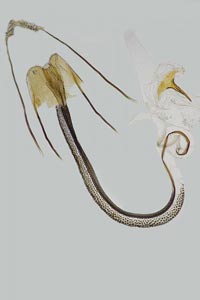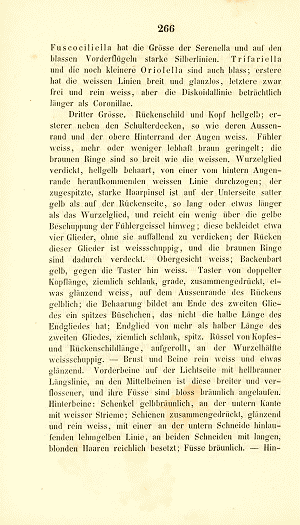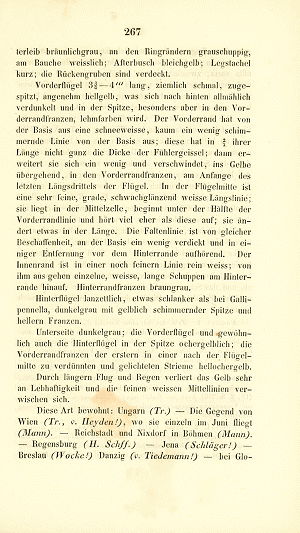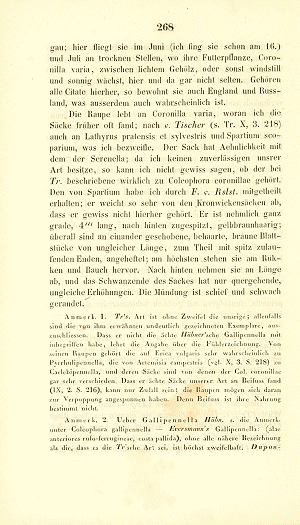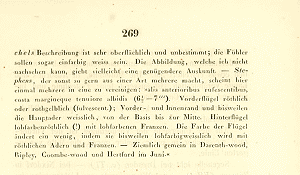

 +27Kontinente:EUAS
+27Kontinente:EUAS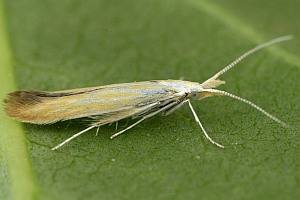
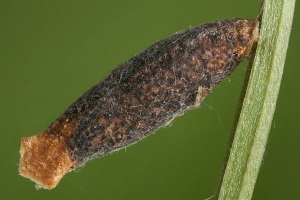
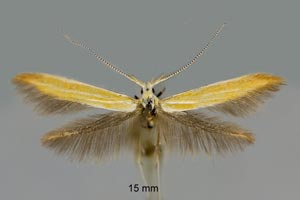
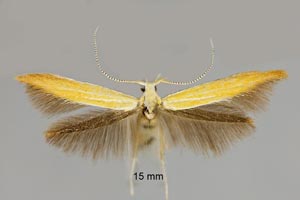
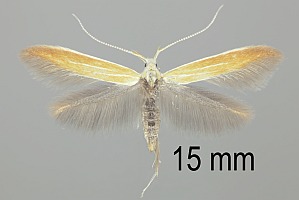


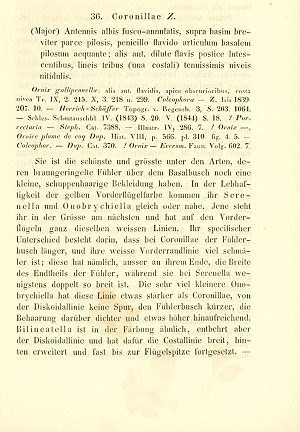
1. Lebendfotos
1.1. Falter
1.2. Raupe, Raupensack
2. Diagnose
2.1. Männchen
2.2. Weibchen
2.3. Geschlecht nicht bestimmt
2.4. Genitalien
2.4.1. Männchen
2.4.2. Weibchen
Genitalabbildungen z.B.: Razowski, J.: Motyle (Lepidoptera) Polski 16 - Coleophoridae, p. 193 (♂), p.231 (♀)
2.5. Erstbeschreibung
3. Biologie
3.1. Nahrung der Raupe
- [Fabaceae:] Securigera varia [= Coronilla varia] (Bunte Beilwicke, Bunte Kronwicke)
- [Fabaceae:] Coronilla coronata ? (Berg-Kronwicke ?)
- [Fabaceae:] Coronilla juncea ? (Binsenartige Kronwicke ?)
- [Fabaceae:] Coronilla minima ? (Kleine Kronwicke ?)
- [Fabaceae:] Coronilla vaginalis ? (Scheiden-Kronwicke ?)
- [Fabaceae:] Astragalus glycyphyllos ??? (Bärenschote, Süßer Tragant ???)
- [Fabaceae:] Lathyrus pratensis ??? (Wiesen-Platterbse ???)
- [Fabaceae:] Lathyrus sylvestris ??? (Wilde Platterbse ???)
Die Raupe lebt an der Bunten Kronwicke. Ob sie daneben noch weitere Fabaceae nutzt, ist unklar. Schon Zeller (1849: 268) hatte diese Pflanze genannt und andere Meldungen angezweifelt: "Die Raupe lebt an Coronilla varia, woran ich die Säcke früher oft fand; nach v. Tischer (s. Tr. X, 3. 218) auch an Lathyrus pratensis et sylvestris und Spartium scoparium, was ich bezweifle." Und er begründet seine Bedenken auch.
Schütze (1931: 129) führt die Art unter "Coronilla", worunter er durchweg Securigera varia verstand. Er vermerkt: "Der Lappensack ist dem von C. serenella [Coleophora colutella] (siehe Astragalus) ähnlich, dicht mit grünen Anhängseln bekleidet, zusammengedrückt, das Afterende stark abwärts gekrümmt (Heinemann). Lathyrus pratensis, Lathyrus sylvestris. Süd- und Mitteleuropa." Das Dumme: C. coronillae lebt nicht in einem Lappensack sondern in einem typischen Röhrensack, der keinerlei Ähnlichkeit mit den Lappensäcken von C. colutella hat.
Bei Baldizzone (2019: 264) heißt es: "Piante nutrici appartenenti alla famiglia Fabaceae: Coronilla divarie specie (coronata, juncea, minima, vaginalis), Securigera varia (Nel, 2002), Astragalus spp., Lathyrus spp. (Hering, 1957)." Die alten, teilweise schon 170 Jahre zuvor zurecht angezweifelten, Angaben werden also - bis auf den sicher falschen Besenginster - weitergeschleppt. Eine Quelle für die 4 Coronilla-Arten wird nicht genannt - hier könnten eigene Beobachtungen des Autors dahinter stecken.
[Bladmineerders.nl (abgefragt 24. Juni 2022)] weicht davon deutlich ab: "HOST PLANTS Fabaceae, monophagous ? Securigera varia. Possibly also Astragalus glycyphyllos and Lathyrus (see note below)." Dort heißt es dann: "In the literature before the publication by Patzak (1974a) mostly it is stated incorrectly that the larva would live in a lobe case. In any case the illustrations and descriptions by Hering (1957a), Toll (1962a) and Razowski (1990a) do not relate to coronillae; it is conceivable that they actually refer to C. oriolella. Faunistical and biological information about coronillae should be treated cautionary therefore. In particular, it remains to be seen of the species lives on other host plants than Securigera."
Tatsächlich hatte schon Patzak (1974: 255) unmissverständlich klargestellt: "Biologie: Raupe im Sommer und Herbst in einem Röhrensack an den Samen von Coronilla. Die Angaben in der gesamten Literatur von Spuler bis Hering und Toll, daß sie in einem Lappensack lebt und miniert, sind falsch. Alle aus Lappensäcken geschlüpften "coronillae" haben sich bei der Untersuchung als crocinella erwiesen. Meine Angaben beruhen auf gezüchtetem Material von Petry, der über diese Biologie bereits in Rapp 1936 schrieb."
(Autor: Erwin Rennwald)
4. Weitere Informationen
4.1. Andere Kombinationen
- Amseliphora coronillae (Zeller, 1849) [so bei Будашкин et al. (2015)]
- Razowskia coronillae (Zeller, 1849) [so bei Anikin et al. (2017)]
4.2. Synonyme
- Ornix gallipennella Treitschke, 1835
- Coleophora constantella Bruand, 1859
4.3. Typenmaterial
Baldizzone (1994: 106) designierte einen Lectotypus: “Lectotypus ♂ [designato in questa sede] conservato al BMNH, reca le seguenti etichette: 1) “LECTOTYPE” (a stampa, rotondo, orlato di blu), 2) “Coronillae Z. Gallipennella Tr. 9,2,215 - Z. 3S. 1839,207” (a mano), 3) “TYPE” (a mano), “B.M. ♂ Genitalia slide No 11114” (a stampa e mano).”
4.4. Literatur
- Anikin, V.V., Sachkov, S.A. & V.V. Zolotuhin (2017): "Fauna lepidopterologica Volgo-Uralensis": from P. Pallas to present days. — Proceedings of the Museum Witt Munich, Volume 7: 1-696; Munich and Vilnius.
- Anikin, V. V. & V. I. Shchurov (2001): Casebearers from Caucasus (Lepidoptera: Coleophoridae). — Zoosystematica Rossica 10 (1): 171-179.
- Lectotypus-Festlegung: Baldizzone, G. (1994): Contribuzioni alla conoscenza dei Coleophoridae LXXV. Coleophoridae dell'Area Irano-Anatolica e regioni limitrofe (Lepidoptera). — Associazione Naturalistica Piemontese Memorie 3: 1-423. Stenstrup (Apollo Books).
- Baldizzone, G. (2019): Fauna d’Italia. Vol. LIII. Lepidoptera Coleophoridae. - XVII + 907 S.; Milano (Calderini).
- Будашкин, Ю. И., Рихтер, И. & Ю. Табель (2015): Новые находки молей-чехлоносок (Lepidoptera: Coleophoridae) в России и в Армении. — Эверсманния 41: 11–22.
- Hering, E. M. (1957): Bestimmungstabellen der Blattminen von Europa einschließlich des Mittelmeerbeckens und der Kanarischen Inseln. Band 1-2: Bestimmungsschlüssel, 1185 S.; Band 3: Zeichnungen, 211 S.; 's-Gravenhage (Uitgeverij Dr. W. Junk).
- Patzak, H. (1974): Beiträge zur Insektenfauna der DDR: Lepidoptera - Coleophoridae. — Beiträge zur Entomologie, 24 (5/8): 153-278. [PDF auf zobodat.at]
- SCHÜTZE (1931): 129
- Watson, R. A. (2023): Coleophora coronillae Zeller, 1849 (Coleophoridae), new to the British Isles. — The Entomologist's Record and Journal of Variation 135 (5): 185-189. [Sekundärzitat nach entrecord.com/contents2305.htm]
- Erstbeschreibung: Zeller, P. C. (1849): Beitrag zur Kenntniss der Coleophoren. — Linnaea Entomologica. Zeitschrift herausgegeben von dem entomologischen Vereine in Stettin 4: 191-416. Berlin (E. S. Mittler und Sohn).


























